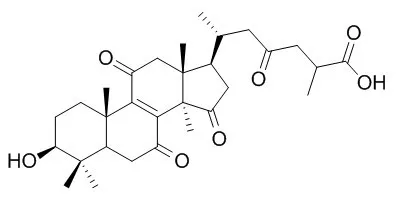To elucidate the cytotoxicity mechanism of Ganoderma triterpenes, a chemoproteomic study using five purified ganoderic acids, ganoderic acid F (GAF), ganoderic acid K (GAK), ganoderic B (GAB), ganoderic acid D (GAD) and Ganoderic acid AM1 (GAAM1) was conducted.
METHODS AND RESULTS:
GAF, GAK, GAB, GAD and Ganoderic acid AM1 treatment for 48 h inhibited the proliferation of HeLa human cervical carcinoma cells with IC(50) values of 19.5+/-0.6 microM, 15.1+/-0.5 microM, 20.3+/-0.4 microM, 17.3+/-0.3 microM, 19.8+/-0.7 microM, respectively. The protein expression profiles of HeLa cells treated with each ganoderic acid at dose of 15 microM for 48 h were checked using two-dimensional electrophoresis (2-DE). The possible target-related proteins of ganoderic acids, i.e. proteins with same change tendency in all five ganoderic acids-treated groups compared with control, were identified using MALDI-TOF MS/MS. Twelve proteins including human interleukin-17E, eukaryotic translation initiation factor 5A (eIF5A), peroxiredoxin 2, ubiquilin 2, Cu/Zn-superoxide dismutase, 14-3-3 beta/alpha, TPM4-ALK fusion oncoprotein type 2, PP2A subunit A PR65-alpha isoform, nucleobindin-1, heterogeneous nuclear ribonucleoprotein K, reticulocalbin 1 and chain A of DJ-1 protein were identified.
CONCLUSIONS:
Ganoderic acids might exert their cytotoxicity by altering proteins involved in cell proliferation and/or cell death, carcinogenosis, oxidative stress, calcium signaling and ER stress. |






 Cell. 2018 Jan 11;172(1-2):249-261.e12. doi: 10.1016/j.cell.2017.12.019.IF=36.216(2019)
Cell. 2018 Jan 11;172(1-2):249-261.e12. doi: 10.1016/j.cell.2017.12.019.IF=36.216(2019) Cell Metab. 2020 Mar 3;31(3):534-548.e5. doi: 10.1016/j.cmet.2020.01.002.IF=22.415(2019)
Cell Metab. 2020 Mar 3;31(3):534-548.e5. doi: 10.1016/j.cmet.2020.01.002.IF=22.415(2019) Mol Cell. 2017 Nov 16;68(4):673-685.e6. doi: 10.1016/j.molcel.2017.10.022.IF=14.548(2019)
Mol Cell. 2017 Nov 16;68(4):673-685.e6. doi: 10.1016/j.molcel.2017.10.022.IF=14.548(2019)